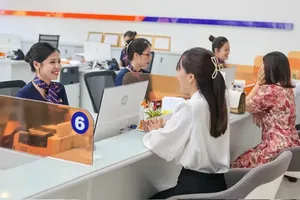
Banks and e-wallet applications are urging customers to promptly update their biometric authentication and identification documents to avoid interruptions in money transfer and withdrawal services at the beginning of the year.
By the end of the year, customers who have not completed their biometric updates will be notified and assisted by commercial banks to complete the process.
Resident Hoang Minh in Binh Chanh outlying district of Ho Chi Minh City said that he has just gone to the bank to update his ID card because it is about to expire. It only took him about 30 minutes to complete the updates of ID card and biometrics.
Biometric authentication will become mandatory for certain online transactions as per the guidelines outlined in the State Bank’s Circulars 17 and 18/2024 regarding payment accounts and bank cards starting January 1, 2025.
Commercial banks will temporarily halt the following online transactions (including money transfers, bill payments, and mobile top-ups), money transfers and withdrawals at ATMs and CDM/STM (advanced ATMs) and the activation and renewal of cards for customers (both individuals and organizational representatives) who have not updated their biometric data and valid identification documents.
To implement the aforementioned circular, commercial banks have been enhancing customer support in the most convenient ways through various methods, including in-branch authentication, digital platform verification, assistance via banking applications, the formation of dedicated support teams, and 24/7 guidance for installing facial biometrics.
For Vietnamese individuals employed overseas who are unable to return home for in-person biometric authentication, banks have introduced remote support options. These include authentication through banking applications and the use of the national electronic identification application (VNeID) for customers with a level 2 electronic identification account.
In contrast, foreigners and individuals of Vietnamese descent who have not established their nationality must undergo the authentication process in person at the bank.
Concurrently, e-wallet applications are actively engaging in promotional efforts to encourage user adoption of biometric authentication. These initiatives include in-app support and the expansion of authentication services across multiple channels.
Biometric authentication safeguards customer assets
The National Cyber Security Association states that utilizing biometric authentication with chip-embedded ID cards for registration and money transfer will result in a limited number of virtual bank accounts. Along with that, the authorities also have the basis to trace criminals and recover illegal money flows.
The SBV’s Payment Department said that according to reports from credit institutions, after implementing biometric authentication since the beginning of July 2024, the number of fraud cases has decreased by 50 percent compared to before.
A substantial reduction in fraudulent transactions has been observed, exceeding 70 percent compared to the average rate during the initial months of 2024. Moreover, certain units have reported a complete absence of subsequent fraudulent incidents. These outcomes underscore the effectiveness of the implemented security enhancements in mitigating fraudulent activities, thereby instilling a greater sense of security and confidence among customers regarding their financial transactions.
Deputy Governor of the State Bank of Vietnam Pham Tien Dung said the regulations in question are designed to tidy up the disorganized state of inactive bank accounts, but at the same time also enhancing the security and privacy aspects of online payment transactions. The latter would reduce the scope of fraud and scams, as well as the practices of attempting to rent, borrow or sell payment accounts. All of which are intended to achieve a paramount objective of safeguarding the very customers themselves amidst the technologically sophisticated crime that, the world over, is on the rise.
Deputy Governor Pham Tien Dung emphasized the significance of implementing biometric authentication to verify that accounts correspond with the identification provided by the Ministry of Public Security. This initiative is a crucial effort to eliminate fraudulent accounts and enhance customer safety. By utilizing facial recognition during payment transactions, it becomes exceedingly difficult for criminals to match the face on the original profile, thereby reducing the risk of unauthorized access to the account holder's funds.
Biometrics is the term used for unique physical characteristics such as fingerprints, face or voice. Biometric payment is a point-of-sale (POS) technology that uses biometric authentication based on physical characteristics to identify the user and authorize the deduction of funds from a bank account. Fingerprint payment, based on finger scanning, is the most common biometric payment method.












)

)









